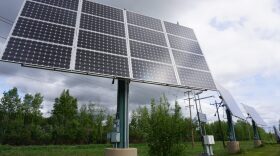-
Documents published by the Alaska Department of Revenue show a multibillion-dollar long-term change in the way money from federal oil leases is handled.
-
A new program at the Department of Energy is pushing the development of nearly a dozen new reactor designs at breakneck speed.
-
Alaska is conducting a “comprehensive review” of insurance companies it says may be discriminating against carbon intensive industries.
-
The Permanent Fund, not oil, is Alaska’s No. 1 source of general-purpose money and has been for years.
-
The lawsuit faults the U.S. Bureau of Land Management for greenlighting ConocoPhillips’ winter seismic and drilling program after a public comment period of only 7 days.
-
The Alaska Department of Transportation says they’ll pay for the infrastructure regardless of whether the ferry terminal gets built.
-
The Trump administration, which broadly opposes renewable energy projects, changed the name of the Colorado-based National Renewable Energy Laboratory to “National Laboratory of the Rockies.”
-
Nullifying the Biden limits means the whole coastal plain of ANWR would be available for potential oil and gas leasing. The Congressional Review Act measure goes next to the president.
-
House Speaker Bryce Edgmon said the proposals were unrealistic given the timeline for a final investment decision.
-
If the campaign is successful, 243 workers at Alpine, Kuparuk and Willow would be represented by the United Steelworkers.
-
Developers’ efforts to overturn the cancellation of a vast gold and copper mine planned for southwest Alaska are getting a boost from national mining and pro-business groups, including the U.S. Chamber of Commerce.
-
The Alaska Oil and Gas Conservation Commission says the fine is justified for enduring, unauthorized injections of enriched gas at a Prudhoe Bay satellite oil field.
Alaska Public Media © 2025. All rights reserved.
Play Live Radio
Next Up:
0:00
0:00
Available On Air Stations












